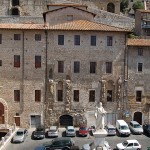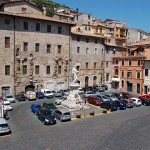The area of piazza Regina Margherita corresponds to the forum, the administrative and religious heart of the ancient city.
The cathedral -dedicated to the martyr Agapitus- lies on temple structures, probably dedicated to Jupiter Emperor, dating from the late 4th century B.C.; the excavations on the eastern side of the church, undertaken in the beginning of 20th century, have revealed the base of the temple, the original paving of the square and part of the stairs set against the base at the end of the 2nd century B.C.
During the 2nd century B.C. the whole city layout has been changed by a urban renewal: first the tuff base of the treasury building was built; then the Basilica structure, center of civil and financial life, was erected: it was the place where trials and all important public matters were held.
On the sides of the Basilica two buildings completed the whole complex: on one side the natural cave framed in masonry structures (the so-called Antro delle Sorti) and paved with The Fishes Mosaic; on the other side the so-called Aula Absidata which housed the famous Nile Mosaic.
In the area of the square just one monument has been found: a monumental exedral fountain that the inhabitants dedicated to fellow citizen Verrius Flaccus, scholar and tutor of Emperor Augustus’ grandsons. This was the place where the old city calendar – so-called Fasti Praenestini – was displayed and maybe decorated with famous Grimani Relieves (displayed in the Palestrina Museum).
.
 Archeopalestrina Percorso archeologico di Palestrina, l'antica Praeneste
Archeopalestrina Percorso archeologico di Palestrina, l'antica Praeneste



